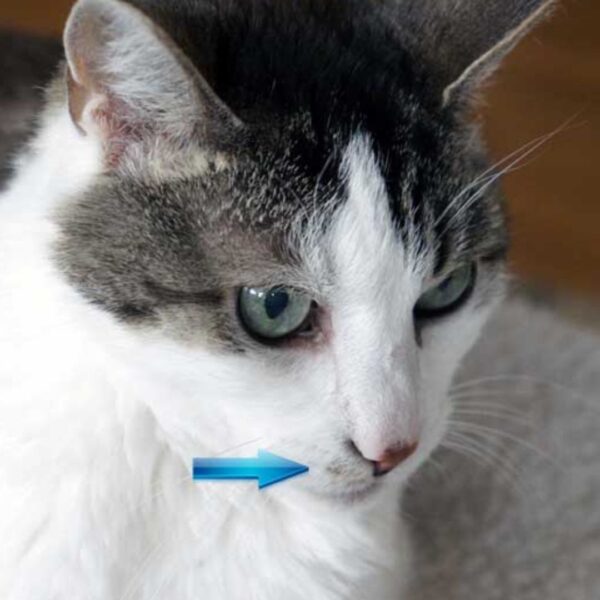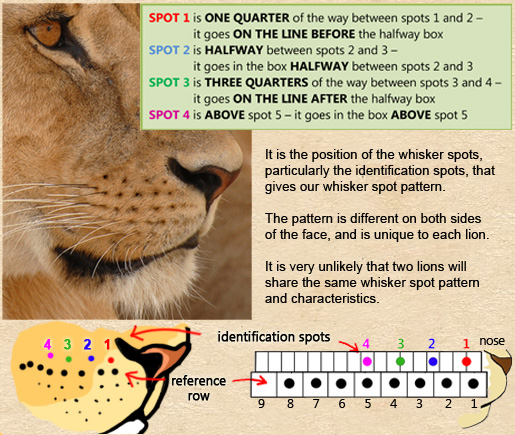
Whisker Spot Patterns: Identifying cats big and small
Whisker spot patterns in cats are a unique feature that can be used for identification purposes. Just as humans have fingerprints, cats possess distinctive patterns in their whisker spots, which do not change over time and are specific to each individual. Identifying animals based on physical characteristics is a fundamental approach in wildlife research and management. With the increasing interest in monitoring and conserving feline species, both wild and domestic, researchers have turned to whisker spot patterns as a reliable noninvasive method of distinguishing among individuals.
The intricate spot patterns of whiskers, or vibrissae, are particularly valuable in studies of small wild cat species where traditional tagging methods can be invasive or even harmful. By using high-resolution images or direct observation, researchers can compare spot patterns to build a database of individual animals, which is invaluable for tracking movements, behaviors, and population dynamics. Furthermore, in the context of domestic cats, such identification techniques are useful for owners and breeders, offering a simple and permanent method to tell apart similarly looking cats.
Key Takeaways
- Whisker spot patterns provide a unique and permanent method for cat identification.
- This noninvasive technique is crucial for research, conservation, and management of feline species.
- It assists in the study of wild populations and serves in the identification of domestic cats.

Biology and Anatomy of Feline Whiskers
Feline whiskers, or vibrissae, are tactile hair structures that serve as an integral part of a cat’s sensory system. These highly specialized features play a crucial role in how cats perceive their environment.
Whisker Functionality
Cat whiskers, primarily used for measuring and detecting changes in their surroundings, are deeply embedded in the cat’s skin and are connected to a muscular and nervous system that is highly sensitive. This sensitivity allows them to detect even the slightest changes in air currents, enabling them to navigate in complete darkness by sensing obstacles or prey nearby.
Whisker Structure and Growth
Whiskers are composed of keratin, the same material that makes up human hair and nails. They go through a growth cycle including phases of rest, shedding, and regrowth. These tactile hairs are thicker and more rigid than ordinary cat fur and are rooted deeply in the skin in areas rich with blood vessels and nerves, such as the cheeks (mystacial), above the eyes (superciliary), on the chin (mandibular), and on the back of the front legs (carpal).
Cat Whisker Diversity
The size, shape, and color of cat whiskers can vary significantly between individuals and breeds, contributing to the unique pattern identification in cats much like a fingerprint. They typically have 8 to 12 pairs of whiskers arranged in rows on each cheek, but this can differ among cats.
Sensory Roles in Cat Behavior
Whiskers serve as a feline’s radar system, gathering sensory information that helps them understand their environment and communicate mood. Cats utilize their sensitive whiskers to judge the width of openings, decide if they can fit through spaces, and aid in hunting by detecting movements of prey. This sensory input is also crucial when cats approach their food and water bowls, as the whiskers help them determine the distance and edges to prevent discomfort or pain from whisker fatigue.

Spot Pattern Identification Techniques
With advancements in technology, researchers have refined methods for the identification of cats using their unique whisker spot patterns. Two primary techniques have emerged: photographic identification process and algorithmic analysis methods. These innovative approaches have revolutionized the way scientists track and study feline populations in the wild.
Photographic Identification Process
The photographic identification process relies heavily on the quality of the image captured. In this context, the use of high-resolution cameras, such as Digital Single-Lens Reflex (DSLR) cameras with resolutions of 18 megapixels or more, is essential. Researchers capture images via camera traps, which can sometimes yield lower resolution photos at around 3.1 megapixels, but advancements in camera trap technology continue to improve image clarity.
Key Steps in Photographic Identification:
- Image Capture: Researchers set up camera traps or photograph animals directly.
- Pattern Analysis: Scientists examine whisker spot patterns—a prime identifiable feature—comparing them across different individuals.
- Cataloging: Identified individuals are cataloged for ongoing observation and study.
Algorithmic Analysis Methods
Algorithmic analysis methods employ computational techniques to enhance the identification process. A significant development in this area is the application of point-pattern matching algorithms, specifically tailored for pattern recognition tasks. The Chamfer Distance Transform is an example of an image matching algorithm used in such applications.
Algorithmic Steps for Identification:
- Input: High-quality images are inputted into the software.
- Algorithmic Processing: The software applies a point-pattern matching algorithm, searching for matching points among known and unknown patterns.
- Identification: The algorithm suggests matches, which experts then verify to confirm the individual identity of the animal.
Algorithmic methods help to automate and streamline the recognition process, which is particularly useful for processing large numbers of images and when dealing with species where individuals look very similar to each other.
Applications in Wildlife Research

Effective wildlife research hinges upon the reliable identification of individual animals, a crucial component for species monitoring and population studies. This section delves into how whisker spot patterns contribute to these research areas, with a focus on non-invasive identification methods such as camera-trapping.
Species Monitoring Strategies
Monitoring strategies for species like lions and leopards utilize camera-trapping to capture imagery of animals’ unique whisker spot patterns. This non-invasive technique allows researchers to track individual animals without the need for physical capture. Individual identification is key to understanding movement patterns, especially with wide-ranging species that may traverse vast and often inhospitable environments.
Population Studies in Unobserved Environments
For prey and predator population studies, especially concerning otariid species and secretive felids, capture-recapture methods employing whisker spot identification provide invaluable data on population demographics. These studies often occur in environments where direct observation is challenging, such as nocturnal or elusive species in dense habitats. Collecting this data is pivotal for wildlife conservation and management, giving insights into animal numbers and health that inform protection measures.
Challenges and Advancements
While the method is indispensable, challenges include the need for high-quality images and distinguishing between individuals with similar spot patterns. Advancements in this field are constantly evolving, making it a promising tool for non-invasive, low labor-intensive surveys of individually identifiable animals. Such advancements improve the accuracy of population studies, essential for the conservation and management of vulnerable species.
whisker spot pattern in Conservation and Management

Whisker spot patterns serve as crucial biometric markers for the identification of individual animals in wildlife conservation and management efforts. These natural markings enhance the accuracy of population parameter estimates and monitoring.
Marine Mammal Identification
In marine biology, identifying individual Australian sea lions (Neophoca cinerea) hinges on unique physical markers. Whisker spot patterns present a non-invasive method for researchers to distinguish individuals within a population. Neophoca cinerea studies often rely on pattern recognition to track life history traits critical to conservation strategies aimed at this vulnerable species.
- Key Applications:
- Monitoring individual life histories
- Population tracking
- Impact assessment of human activities
Endangered Cat Species Protection
For terrestrial species like the elusive and endangered Amur leopard cat (Prionailurus bengalensis euptilurus), conservationists in regions like South Korea use whisker spot patterns for individual identification. Recognizing individual cats allows scientists to derive precise population estimates, understand behavioral ecology, and implement targeted conservation measures.
- Examples of Conservation Impacts:
- Detailed population censuses
- Enhanced understanding of territorial ranges
- Informed decision-making for habitat protection efforts
Through the identification of Amur leopard cats using these natural markings, efforts in South Korea have grown in precision and effectiveness, strengthening the protection of this endangered species and increasing the odds of its survival.
Whisker spot pattern for Domestic Cat Identification
Cats possess unique identification markers such as whisker spots, coat patterns, and eye color that aid in their individual recognition. These physical characteristics are pivotal for various aspects of feline management and care.
Ownership and Shelter Management
When it comes to ownership and shelter management, precise identification of cats is essential. Key physical markers include:
- Whisker Spots: Often unique in pattern, akin to a human fingerprint.
- Coat Patterns and Colors: Varied and can be distinctive, particularly in breeds with specific markings.
- Eyes: Color and shape can sometimes be indicative of breed.
Proper identification through such markers can not only streamline shelter operations but also assist in reuniting lost pets with their owners. Additionally, they are important for maintaining accurate records of the shelter population and for the management of breeding programs.
- Markings on Muzzle and Cheeks: These areas particularly may have distinct patterns.
- Legs: Bandings or color disparities can signal individual identity.
Identification strategies such as photographic databases and collar tags leverage these features. Moreover, microchipping provides an invisible yet permanent method to ensure accurate and long-term identification.
Health and Behavioral Assessment
The potential health and behavioral assessment of domestic cats also heavily depends on their physical attributes.
- Age: Determined through features like coat quality and tooth wear, it’s a vital aspect of health assessment.
- GI (Gastrointestinal) Health: Some coat patterns, especially around the belly, can indicate issues upon changes such as stain or discoloration.
Understanding individual traits like whisker spots can shed light on a cat’s mood and behavior. Behaviorists note that certain coat patterns and colors may correspond with different behavioral tendencies, although generalizations should be made cautiously. For instance, a cat with a calm demeanor may carry itself in a way that causes less wear on fur and whisker markings.
Regular tracking of these identifiers can reveal changes that indicate health issues, allowing for timely veterinary intervention. It is important to record:
- Behavior: Daily tracking can signal shifts indicative of health issues.
- Coat Changes: New stains or alterations in coat color or patterns could signify underlying conditions.
By understanding and documenting the nuanced physical details of each cat, caretakers can provide better health management and more personalized care.
Frequently Asked Questions
This section addresses common questions about the patterns of spots located near a cat’s whiskers, their implications, and the methodologies used in their analysis.
How can the patterns of spots on a cat’s whiskers be identified and interpreted?
The patterns of spots near a cat’s whiskers can be identified through close observation and photography. Experts interpret these patterns by comparing them to known variations within feline species, often using them to identify individual animals in research.
What are the implications of various whisker spot patterns in felines?
Whisker spot patterns may have implications in identifying individual cats within a population. These patterns are unique to each cat and do not generally correlate with behavior or personality.
What do changes in whisker spot patterns indicate about a cat’s health?
Any noticeable changes in a cat’s whisker spot patterns, such as fading or discoloration, could indicate health issues. It is critical to monitor these changes and consult with a veterinarian for a thorough assessment.
Are there specific technologies or applications that assist in analyzing cat whisker spot patterns?
There are technologies and applications designed to assist in the analysis of cat whisker spot patterns. These may include specialized software that can catalogue and match spot patterns to aid in research or conservation efforts.
How do the types and positions of a cat’s whiskers relate to their sensory functions?
The types and positions of whiskers are closely related to a cat’s sensory functions. They help felines navigate their environment, providing tactile feedback and aiding in spatial awareness and hunting.
Can whisker spot patterns be used to distinguish between different breeds or individual cats?
While whisker spot patterns are not typically used to distinguish between different breeds, they are effective in identifying individual cats, much like fingerprints in humans. This characteristic is particularly useful in scientific studies and wildlife conservation.